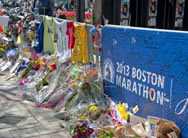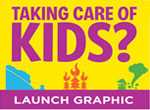Remembering Boston: Dr. Stavas’ Story
Note to Readers: This story contains a description of a bombing scene and on site trauma care. Content may be too graphic for some readers.
Health providers can take on many roles when responding during a disaster. They can use basic medical training and available resources, to help care for children and other populations during and after an emergency.

A memorial for the victims of the Boston Marathon
Dr. Natalie Stavas was nearing the end. She had survived the long training runs, a broken foot, sheer exhaustion, and Heartbreak Hill. She was in the final stretch of the race when two explosions changed the definition of “surviving” and transformed a runner into a physician providing trauma care to critically injured Boston Marathon spectators.
Jumping over barricades and sprinting through the crowd, Dr. Stavas arrived at the second blast site and met a scene worse than any nightmare. The air itself assaulted her senses - the taste of blood, the smell of burning flesh, the screams of injured runners and bystanders.
While her daily job focuses on children, she sprang into action treating victims of all ages. She began administering CPR to a young woman who tragically passed away. She then turned her attention to other victims.
With no supplies other than the clothes on their backs, Dr. Stavas and fellow bystanders worked to treat blast injuries. Creativity and urgent needs turned clothes into tools. “What can you do with only your hands and a T-shirt? It turns out you can do a lot,” said Dr. Stavas. “You can tie the shirt around a separated limb to stop the bleeding. You can stuff the shirt into the groin to compress an artery ripped apart by bomb fragments. You can cover an abdomen with organs exposed. You can wrap it around a bleeding head wound.”
Lessons Learned
A critical factor in saving the lives of many was the willingness of Dr. Stavas and others to use whatever training and tools they had available at the scene, while preparation allowed the rest of the emergency response system to continue saving lives. “Although we were taken by complete surprise, the quick response and activation of the disaster system worked so well; everyone who left the scene alive stayed alive,” said Dr. Stavas. “From the ambulance dispatchers, to the EMS personal, to the custodians who rapidly cleaned the trauma bays in preparation for the next patient. Everyone understood their role, fulfilled their role, and played a crucial part in meeting the needs of over 200 patients.”
Following the initial trauma, the focus shifted to recovery. Not only did patients need to recover, but the community itself was grieving. “How do you help those with invisible injuries? How do you explain to a child why they lost their leg why they lost their brother?” said Dr. Stavas. “At first recovery seemed impossible, but the community of Boston did something extraordinary. We came together with a common cause, the understanding that everyone was affected, everyone had a story to share, and only through sharing would healing begin.”
Dr. Stavas showed how health providers can respond to emergencies by using basic medical or first aid training. Although pediatricians are the primary doctors for children, any doctor can use basic medical skills to prepare for and respond to emergencies that may affect children.
For more information on emergency preparedness and the role of health providers visit, http://www.cdc.gov/childrenindisasters/professionals.html.
More Resources
This story was provided courtesy of the American Academy of Pediatrics and Dr. Natalie Stavas. Dr. Stavas is an attending physician at Boston Children’s Hospital and an Instructor in Pediatrics at Harvard Medical School.
- Page last reviewed: February 11, 2015
- Page last updated: February 11, 2015
- Content source:


 ShareCompartir
ShareCompartir



